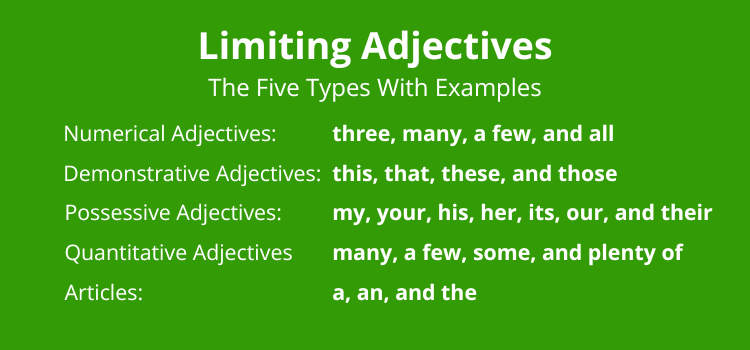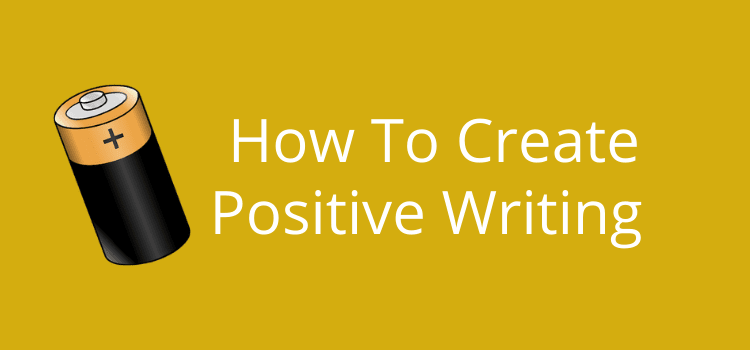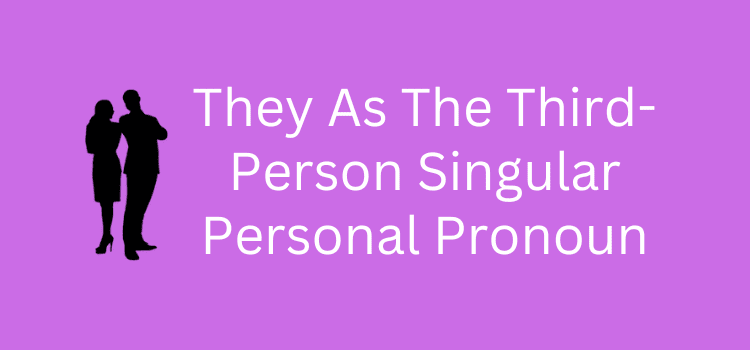
Limiting adjectives, like limiting modifiers, are words or phrases we use to modify nouns by including specific information about them.
These adjectives limit or narrow the scope of the noun they describe.
Unlike descriptive adjectives, limiting adds precision to all forms of writing. You probably use them all the time without knowing what they are or what they do.
Here’s a quick summary to help you identify them and decide when to use them best.
What do limiting adjectives do?
These are words that restrict or limit nouns or pronouns by telling us which one, what kind, how many, or whose.
They are essential because they help us identify specific nouns or groups of nouns and convey different meanings.
For example, in the sentence, I own two bicycles, the limiting adjective two tells us that the speaker owns exactly two bicycles.
However, in the sentence, I own some bicycles, the limiting adjective some tells us that the speaker owns at least one bicycle, but we don’t know how many in total.
We can also restrict or limit a noun with an article.
I own an electric bicycle, which means only one, but there could be more that are not electric.
The bicycle I own is electric, also means one, but the definite article the indicates that it is probably the speaker’s only bicycle.
As with any word choice, you need to be careful not to overuse limiting adjectives.
They have a place, but sometimes, it’s better to find alternatives if there is no need for precision or restriction.
Here’s a list of the forms to help you identify these adjectives.
The 5 types of limiting adjectives

1. Numerical Adjectives
These provide a precise quantity or number of items.
Common examples include a specific number such as three, or many, a few, and all.
For instance, she has three houses, specifies the exact number of houses, offering a clear understanding.
Similarly, I ate all the mandarins, leaves no doubt that every single one of the mandarins was eaten.
However, she has a few close friends is not as precise, but it still indicates a number of less than four.
2. Demonstrative Adjectives
Adjectives like these help in pointing out specific items.
Common demonstrative adjectives are this, that, these, and those.
This article is interesting tells us exactly which article we’re talking about.
Those shoes are on sale, indicates a particular type or brand of shoes.
3. Possessive Adjectives
Indicating ownership, possessive adjectives include my, your, his, her, its, our, and their.
For example, their house is beautiful, specifies whose house is beautiful.
Her puppy is playful tells us about the puppy owned by a particular person.
4. Quantitative Adjectives
These adjectives convey the approximate quantity or degree of something.
Examples are many, a few, some, and plenty of.
I have plenty of time before my meeting indicates a sufficient amount of time.
We need some help with this marketing project implies a need for assistance without specifying an amount.
5. Articles
A, an, and the are articles, which are specific types of limiting adjectives.
A and an are indefinite articles, referring to any one of a kind, while the is the definite article, specifying a particular thing.
For example, the book on the shelf is mine identifies a specific book.
In contrast, an apple a day keeps the doctor away uses both an and the to denote any one apple and any one doctor in a general sense.
Using limiting adjectives effectively
Using these adjectives effectively can significantly improve your communication.
Here are some tips on how to use them.
1. Clarity
Limiting adjectives enhance clarity by specifying nouns.
They help your audience understand precisely what you are talking about, reducing ambiguity.
For example, pass me that book, is more precise than saying pass me a book.
2. Context
Always consider the context of your text.
Choose limiting adjectives that best fit the situation and convey the precise information you want to share.
In a grocery store, I would like some apples, is contextually appropriate, but I would like those apples, might be better when referring to the specific apples the shopper wants.
3. Avoid Overuse
While limiting adjectives are important, avoid overloading your sentences with them.
Balance is key to maintaining readability and flow in your writing and conversations.
Both of the two cute, fluffy kittens are sitting on the soft, plush couch.
But this sentence is weighed down by numerous limiting adjectives, making it cumbersome.
Simplifying it to both kittens are on the couch maintains clarity and conciseness.
4. Vary Your Vocabulary
When you use a variety of limiting adjectives, it helps to keep your language engaging and avoid repetition.
Synonyms and alternative adjectives can add depth to your expressions.
For instance, instead of saying I have many books, you could say, I possess a bundle of books, or I own a collection of books.
5. Placement
The limiting adjective always comes before the noun and descriptive adjectives.
Tania grows beautiful roses. (descriptive)
Tania grows many beautiful roses. (limited)
I like my old friends the best. (descriptive)
I like a few of my old friends the best. (limited)
Summary
We use restricting adjectives all the time in our writing without much thought. It’s hard to avoid them.
But it’s a grammar point that is worth considering occasionally.
Do you use them too often? I know I do.
However, limiting adjectives are useful to make a noun more specific and provide context in a sentence.
They help convey information about the noun’s quantity, ownership, definiteness, or proximity.
Without limiting adjectives, sentences might lack precision and clarity, making them more challenging to understand.
However, a little goes a long way.
When you next notice one, consider if you could use fewer limited adjectives.
All of the students passed the difficult exam with flying colors. (Limited)
The students passed the difficult exam with flying colors. (Non-limited)
We saw a few curious tourists exploring the historic site. (Limited)
We saw curious tourists exploring the historic site. (Non-limited)
It’s relatively easy to rewrite a sentence from time to time without changing the meaning.
But it always depends on what you want to say and how you want to say it.
Related Reading: I’ve Not, And I Haven’t Are Both Correct In Writing



